A Systematic Literature Review on Waste-to-Resource Potential of Palm Oil Clinker for Sustainable Engineering and Environmental Applications
Abstract
:1. Introduction
Sustainable Approach for Oil Palm Waste Handling
- Generation of biobased chemicals: furfural, 2,3-butanediol, lactic acid, succinic acid, levulinic acid, xylitol, and oxalic acid;
- Biochar production;
- Fertilizer and animal feed;
- Fermentation medium;
- Microalgal growth medium;
- Renewable source of carotene;
- Biopolymer production;
- Manufacturing of engineered wood products such as particle, composite, and fiber board;
- Reinforcing agent;
- Filler;
- Adhesive;
- Isolation of cellulose nanofiber, microcrystalline cellulose, and nanocrystalline cellulose;
- Pulp and paper production;
- Precursor material in coir fiber, roofing tile, card paper, and cement board manufacturing.
| Thousand Metric Tonne | ||||||
|---|---|---|---|---|---|---|
| Production | 2016/2017 | 2017/2018 | 2018/2019 | 2019/2020 | 2020/2021 (July) | 2020/2021 (Aug) |
| Indonesia | 36,000 | 39,500 | 41,500 | 42,500 | 43,500 | 43,500 |
| Malaysia | 18,858 | 19,683 | 20,800 | 19,000 | 19,300 | 19,700 |
| Thailand | 2500 | 2780 | 3000 | 2800 | 3100 | 3100 |
| Colombia | 1146 | 1627 | 1632 | 1529 | 1670 | 1670 |
| Nigeria | 990 | 1025 | 1015 | 1015 | 1015 | 1015 |
| Other | 5845 | 5960 | 6077 | 5927 | 6013 | 6013 |
| Total | 65,339 | 70,575 | 74,024 | 72,771 | 74,598 | 74,998 |
2. Methodology
2.1. Specific Research Questions
2.2. Criteria and Bibliographical Search Strategy
2.3. Screening
2.4. Criteria for Article Exclusion and Inclusion
2.5. Data Analysis
3. Waste-to-Resource Potential of POC
3.1. POC in Geopolymer Structural Elements
3.2. POC in Conventional Structural Elements
3.2.1. POC as a Coarse Aggregate
| Size of Aggregate (mm) | Bulk Dry Density (kg/m3) | Saturated Density (kg/m3) | Specific Gravity | Water Absorption (%) | Aggregate Impact Value | Aggregate Crushing Value (%) | Fineness Modulus | Moisture Content (%) | Los Angeles Abrasion (%) | Compressive Strength (MPa) @ 28 Days | Splitting Tensile Strength (MPa) | Flexural Strength (MPa) | Ref. |
|---|---|---|---|---|---|---|---|---|---|---|---|---|---|
| ‒ | 2050 | 2076 | ‒ | ‒ | ‒ | ‒ | ‒ | ‒ | ‒ | 57 | ‒ | ‒ | [50] |
| 5‒14 | 823 | ‒ | 1.62 | 4.43 | ‒ | 18.04 | ‒ | ‒ | 26.21 | >30 | ‒ | ‒ | [49] |
| ‒ | 1471 | 65 | ‒ | 3.91 | ‒ | ‒ | 5.88 | ‒ | ‒ | 57.8 | 3.79 | ‒ | [55] |
| 4.75–10 | 732 | ‒ | 1.81 | 4.35 | ‒ | 56.44 | ‒ | 0.28 | ‒ | 55.2–83.5 | ‒ | 4–7.8 | [22] |
| 5‒14 | 781.08 | 1769.2 | 1.82 | 4.35 | 25.36 | 18.08 | 27.09 | 0.07 | 27.09 | 30.9 | 2.29 | ‒ | [56] |
| ‒ | 860 | ‒ | 1.69 | 7 | 36.3 | 21.2 | ‒ | ‒ | 23.9 | ‒ | 3.05–3.31 | 4.48–5.38 | [57] |
| ‒ | 1419 | 1875–1995 | 1.9 | 4.23 | 26.01 | 18.04 | 4.99 | ‒ | 27.08 | 50–60 | 3.2–4.6 | ‒ | [58] |
| ‒ | 782 | ‒ | 1.8 | 3.56 | ‒ | ‒ | 6.32 | ‒ | ‒ | 61.67 | ‒ | ‒ | [16] |
| 4.75–14 | 732 | ‒ | 1.73 | 3 ± 2 | ‒ | 56.44 | ‒ | 0.5 | ‒ | 33.01–39.32 | 2.61–3.28 | 3.75–4.42 | [20] |
| 4.75–9.5 | 732 | ‒ | 1.88 | 3 ± 2 | ‒ | 56.44 | ‒ | ‒ | ‒ | 3.43–9.52 | ‒ | ‒ | [53] |
| 5‒14 | 732 | ‒ | 1.73 | 3 ± 2 | ‒ | 56.44 | ‒ | 1 ± 0.5 | ‒ | 33–49 | ‒ | ‒ | [27] |
| 5–12.5 | 781.08 | ‒ | 1.82 | 4.35 | 25.36 | ‒ | ‒ | ‒ | 27.09 | 46 | ‒ | ‒ | [59] |
| ‒ | 817 | ‒ | 1.92 | ‒ | ‒ | ‒ | 2.6 | 1.3 | 38.7 | ‒ | ‒ | ‒ | [54] |
| ‒ | 568 | ‒ | 1.75 | 5.67 | 27.31 | ‒ | ‒ | 0.08 | 25.05 | ‒ | ‒ | ‒ | [60] |
| ‒ | 793 | ‒ | 1.76 | 4.67 | 48.6 | 47.9 | ‒ | ‒ | ‒ | ‒ | ‒ | ‒ | [41] |
| ‒ | ‒ | ‒ | ‒ | ‒ | ‒ | ‒ | ‒ | ‒ | ‒ | 27.51 | ‒ | 2.54 | [18] |
| <4.75 | 811 | ‒ | 2.15 | 5.75 | ‒ | ‒ | ‒ | 0.11 | ‒ | ‒ | ‒ | ‒ | [22] |
| <5 | 1118.86 | ‒ | 2.01 | 26.45 | ‒ | ‒ | 3.31 | 0.11 | ‒ | ‒ | ‒ | ‒ | [56] |
| <5 | 811 | ‒ | 2.15 | 10 ± 5 | ‒ | ‒ | ‒ | 0.5 ± 0.25 | ‒ | ‒ | ‒ | ‒ | [44] |
| ‒ | 918 | ‒ | 1.98 | ‒ | ‒ | ‒ | 2.3 | 1.27 | ‒ | ‒ | ‒ | ‒ | [54] |
| ≤4.775 | ‒ | ‒ | 1.92 | 3.3 ± 1 | ‒ | ‒ | 3.52 | 1.5 ± 0.5 | ‒ | 53 | ‒ | ‒ | [28] |
| ‒ | 113 | ‒ | 2.08 | 3.6 | ‒ | ‒ | 3.12 | ‒ | ‒ | ‒ | ‒ | ‒ | [61] |
| ≤4.75 | 835.2 | ‒ | 1.92 | 3.3 ± 1 | ‒ | ‒ | 3.52 | 1.5 ± 0.5 | ‒ | ‒ | ‒ | ‒ | [23] |
| ‒ | 1085 | ‒ | 1.94 | 9.77 | ‒ | ‒ | 2.6 | 0.27 | ‒ | ‒ | ‒ | ‒ | [37] |
3.2.2. POC as a Fine Aggregate
3.2.3. POC Powder
3.3. POC in Wastewater Treatment
3.4. Soil Stabilization
3.5. Highway Construction Material
3.6. POC as a Catalyst
3.7. POC as a Bio-Filler
4. Pretreatment of POC for Performance Enhancement
4.1. Effect of Hydrochloric (HCl) Acid and Magnesium Sulfate (MgSO4) Attack
4.2. Effect of Thermal and Chemical Treatment on POC Structural Elements
5. Conclusions
Funding
Institutional Review Board Statement
Informed Consent Statement
Data Availability Statement
Acknowledgments
Conflicts of Interest
References
- Duque-Acevedo, M.; Belmonte-Urena, L.J.; Cortés-García, F.J.; Camacho-Ferre, F. Agricultural waste: Review of the evolution, approaches and perspectives on alternative uses. Glob. Ecol. Conserv. 2020, 22, e00902. [Google Scholar] [CrossRef]
- Harun, N.Y.; Han, T.J.; Vijayakumar, T.; Saeed, A.; Afzal, M. Ash deposition characteristics of industrial biomass waste and agricultural residues. Mater. Today Proc. 2019, 19, 1712–1721. [Google Scholar] [CrossRef]
- Ukanwa, K.; Patchigolla, K.; Sakrabani, R.; Anthony, E.; Mandavgane, S. A review of chemicals to produce activated carbon from agricultural waste biomass. Sustainability 2019, 11, 6204. [Google Scholar] [CrossRef] [Green Version]
- Lee, Z.S.; Chin, S.Y.; Lim, J.W.; Witoon, T.; Cheng, C.K. Treatment technologies of palm oil mill effluent (POME) and olive mill wastewater (OMW): A brief review. Environ. Technol. Innov. 2019, 15, 100377. [Google Scholar] [CrossRef]
- Meschini, R.; Eliseo, D.D.; Filippi, S.; Bertini, L.; Bizzarri, B.M.; Botta, L.; Saladino, R.; Velotti, F. Tyrosinase-treated hydroxytyrosol-enriched olive vegetation waste with increased antioxidant activity promotes autophagy and inhibits the inflammatory response in human THP-1 monocytes. J. Agric. Food Chem. 2018, 66, 12274–12284. [Google Scholar] [CrossRef] [PubMed]
- Cádiz-Gurrea, M.; Pinto, D.; Delerue-Matos, C.; Rodrigues, F. Olive fruit and leaf wastes as bioactive ingredients for cosmetics—A preliminary study. Antioxidants 2021, 10, 245. [Google Scholar] [CrossRef] [PubMed]
- De Matteis, V.; Rizzello, L.; Ingrosso, C.; Rinaldi, R.; Research, P. Purification of olive mill wastewater through noble metal nanoparticle synthesis: Waste safe disposal and nanomaterial impact on healthy hepatic cell mitochondria. Environ. Sci. Pollut. Res. 2021, 28, 26154–26171. [Google Scholar] [CrossRef]
- Cheng, Y.W.; Chong, C.C.; Lam, M.K.; Ayoub, M.; Cheng, C.K.; Lim, J.W.; Yusup, S.; Tang, Y.; Bai, J. Holistic process evaluation of non-conventional palm oil mill effluent (POME) treatment technologies: A conceptual and comparative review. J. Hazard. Mater. 2020, 409, 124964. [Google Scholar] [CrossRef]
- Jagaba, A.; Kutty, S.; Hayder, G.; Baloo, L.; Ghaleb, A.; Lawal, I.; Abubakar, S.; Al-dhawi, B.; Almahbashi, N.; Umaru, I. Degradation of Cd, Cu, Fe, Mn, Pb and Zn by Moringa-oleifera, zeolite, ferric-chloride, chitosan and alum in an industrial effluent. Ain Shams Eng. J. 2021, 12, 57–64. [Google Scholar] [CrossRef]
- Solarte-Toro, J.C.; González-Aguirre, J.A.; Giraldo, J.A.P.; Alzate, C.A.C.; Reviews, S.E. Thermochemical processing of woody biomass: A review focused on energy-driven applications and catalytic upgrading. Renew. Sustain. Energy Rev. 2021, 136, 110376. [Google Scholar] [CrossRef]
- Nur, M.M.A.; Buma, A.G.J. Opportunities and challenges of microalgal cultivation on wastewater, with special focus on palm oil mill effluent and the production of high value compounds. Waste Biomass Valoriz. 2019, 10, 2079–2097. [Google Scholar] [CrossRef] [Green Version]
- Hii, K.-L.; Yeap, S.-P.; Mashitah, M.D. Cellulase production from palm oil mill effluent in Malaysia: Economical and technical perspectives. Eng. Life Sci. 2012, 12, 7–28. [Google Scholar] [CrossRef]
- Poh, P.E.; Wu, T.Y.; Lam, W.H.; Poon, W.C.; Lim, C.S. Waste Management in the Palm Oil Industry: Plantation and Milling Processes; Springer Nature: Basingstoke, UK, 2020. [Google Scholar]
- Saad, M.S.; Wirzal, M.D.H.; Putra, Z.A. Review on current approach for treatment of palm oil mill effluent: Integrated system. J. Environ. Manag. 2021, 286, 112209. [Google Scholar] [CrossRef] [PubMed]
- Kanadasan, J.; Razak, H.A. Mix design for self-compacting palm oil clinker concrete based on particle packing. Mater. Des. 2014, 56, 9–19. [Google Scholar] [CrossRef] [Green Version]
- Jumaat, M.Z.; Alengaram, U.J.; Ahmmad, R.; Bahri, S.; Islam, A.B.M.S. Characteristics of palm oil clinker as replacement for oil palm shell in lightweight concrete subjected to elevated temperature. Constr. Build. Mater. 2015, 101, 942–951. [Google Scholar] [CrossRef]
- Mustapa, S.; Sulong, N.R. Performance of palm oil clinker as a bio-filler with hybrid fillers in intumescent fire protective coatings for steel. Sains Malays. 2017, 46, 2489–2496. [Google Scholar]
- Ibrahim, M.H.W.; Mangi, S.A.; Ridzuan, M.B.; Burhanudin, M.; Jamaluddin, N.; Li, K.H.; Shahidan, S.; Khalid, F.S.; Arshad, M.F.; Jaya, R.P. Compressive and flexural strength of concrete containing palm oil biomass clinker with hooked-end steel fibers. Int. J. Integr. Eng. 2018, 10, 53–57. [Google Scholar]
- Babalghaith, A.M.; Koting, S.; Sulong, N.H.R.; Karim, M.R.; AlMashjary, B.M. Performance evaluation of stone mastic asphalt (SMA) mixtures with palm oil clinker (POC) as fine aggregate replacement. Constr. Build. Mater. 2020, 262, 120546. [Google Scholar] [CrossRef]
- Abutaha, F.; Razak, H.A.; Ibrahim, H.A. Effect of coating palm oil clinker aggregate on the engineering properties of normal grade concrete. Coatings 2017, 7, 175. [Google Scholar] [CrossRef] [Green Version]
- Karim, M.R.; Hashim, H.; Razak, H.A.; Yusoff, S. Characterization of palm oil clinker powder for utilization in cement-based applications. Constr. Build. Mater. 2017, 135, 21–29. [Google Scholar] [CrossRef]
- Abutaha, F.; Razak, H.A.; Ibrahim, H.A.; Ghayeb, H.H. Adopting particle-packing method to develop high strength palm oil clinker concrete. Resour. Conserv. Recycl. 2018, 131, 247–258. [Google Scholar] [CrossRef]
- Darvish, P.; Alengaram, U.J.; Poh, Y.S.; Ibrahim, S.; Yusoff, S. Volume based design approach for sustainable palm oil clinker as whole replacement for conventional sand in mortar. J. Build. Eng. 2020, 32, 101660. [Google Scholar] [CrossRef]
- Karim, M.R.; Yusoff, S.; Razak, H.A.; Chowdhury, F.I.; Zabed, H. Heavy metals leaching behaviour assessment of palm oil clinker. Sains Malays. 2018, 47, 523–530. [Google Scholar] [CrossRef]
- Ahmmad, R.; Alengaram, U.J.; Jumaat, M.Z.; Sulong, N.R.; Yusuf, M.O.; Rehman, M.A. Feasibility study on the use of high volume palm oil clinker waste in environmental friendly lightweight concrete. Constr. Build. Mater. 2017, 135, 94–103. [Google Scholar] [CrossRef]
- Kabir, S.A.; Alengaram, U.J.; Jumaat, M.Z.; Yusoff, S.; Sharmin, A.; Bashar, I.I. Performance evaluation and some durability characteristics of environmental friendly palm oil clinker based geopolymer concrete. J. Clean. Prod. 2017, 161, 477–492. [Google Scholar] [CrossRef]
- Alnahhal, M.F.; Alengaram, U.J.; Jumaat, M.Z.; Abutaha, F.; Alqedra, M.A.; Nayaka, R.R. Assessment on engineering properties and CO2 emissions of recycled aggregate concrete incorporating waste products as supplements to Portland cement. J. Clean. Prod. 2018, 203, 822–835. [Google Scholar] [CrossRef]
- Darvish, P.; Alengaram, U.J.; Poh, Y.S.; Ibrahim, S.; Yusoff, S. Performance evaluation of palm oil clinker sand as replacement for conventional sand in geopolymer mortar. Constr. Build. Mater. 2020, 258, 120352. [Google Scholar] [CrossRef]
- Yaro, N.; Napiah, M.; Sutanto, M.; Usman, A.; Saeed, S.; Kaura, J. Influence of modification mixing parameters on conventional properties of palm oil clinker fine (POCF)-modified bitumen. Mater. Today Proc. 2021. [Google Scholar] [CrossRef]
- Kanadasan, J.; Razak, H.A.; Subramaniam, V. Properties of high flowable mortar containing high volume palm oil clinker (POC) fine for eco-friendly construction. J. Clean. Prod. 2018, 170, 1244–1259. [Google Scholar] [CrossRef]
- Karim, M.R.; Khandaker, M.U.; Asaduzzaman, K.; Razak, H.A.; Yusoff, S. Radiological risks assessment of building materials ingredients: Palm oil clinker and fuel ash. Indoor Built Environ. 2019, 28, 479–491. [Google Scholar] [CrossRef]
- Alnahhal, M.F.; Alengaram, U.J.; Jumaat, M.Z.; Alsubari, B.; Alqedra, M.A.; Mo, K.H. Effect of aggressive chemicals on durability and microstructure properties of concrete containing crushed new concrete aggregate and non-traditional supplementary cementitious materials. Constr. Build. Mater. 2018, 163, 482–495. [Google Scholar] [CrossRef]
- Karim, M.R.; Chowdhury, F.I.; Zabed, H.; Saidur, M. Effect of elevated temperatures on compressive strength and microstructure of cement paste containing palm oil clinker powder. Constr. Build. Mater. 2018, 183, 376–383. [Google Scholar] [CrossRef]
- Nayaka, R.R.; Alengaram, U.J.; Jumaat, M.Z.; Yusoff, S.B.; Alnahhal, M.F. High volume cement replacement by environmental friendly industrial by-product palm oil clinker powder in cement–lime masonry mortar. J. Clean. Prod. 2018, 190, 272–284. [Google Scholar] [CrossRef]
- Kanadasan, J.; Abdul Razak, H. Utilization of palm oil clinker as cement replacement material. Materials 2015, 8, 8817–8838. [Google Scholar] [CrossRef] [PubMed] [Green Version]
- Hamada, H.; Alattar, A.; Yahaya, F.; Muthusamy, K.; Tayeh, B.A. Mechanical properties of semi-lightweight concrete containing nano-palm oil clinker powder. Phys. Chem. Earth Parts A/B/C 2021, 121, 102977. [Google Scholar] [CrossRef]
- Shakir, A.A.; Ibrahim, M.W.; Othman, N.; Mohammed, A.A.; Burhanudin, M. Production of eco-friendly hybrid blocks. Constr. Build. Mater. 2020, 257, 119536. [Google Scholar] [CrossRef]
- Ismail, A.H.; Kusbiantoro, A.; Chin, S.C.; Muthusamy, K.; Islam, M.; Tee, K.F. Pozzolanic reactivity and strength activity index of mortar containing palm oil clinker pretreated with hydrochloric acid. J. Clean. Prod. 2020, 242, 118565. [Google Scholar] [CrossRef]
- Jagaba, A.; Kutty, S.; Hayder, G.; Latiff, A.; Aziz, N.; Umaru, I.; Ghaleb, A.; Abubakar, S.; Lawal, I.; Nasara, M. Sustainable use of natural and chemical coagulants for contaminants removal from palm oil mill effluent: A comparative analysis. Ain Shams Eng. J. 2020, 11, 951–960. [Google Scholar] [CrossRef]
- Baloo, L.; Isa, M.H.; Sapari, N.B.; Jagaba, A.H.; Wei, L.J.; Yavari, S.; Razali, R.; Vasu, R. Adsorptive removal of methylene blue and acid orange 10 dyes from aqueous solutions using oil palm wastes-derived activated carbons. Alex. Eng. J. 2021, 60, 5611–5629. [Google Scholar] [CrossRef]
- Feen, O.S.; Mohamed, R.N.; Mohamed, A.; Khalid, N.H.A. Effects of coarse palm oil clinker on properties of self-compacting lightweight concrete. J. Teknol. 2017, 79. [Google Scholar] [CrossRef] [Green Version]
- Cheng, Y.W.; Chong, C.C.; Cheng, C.K.; Ng, K.H.; Witoon, T.; Juan, J.C. Ethylene production from ethanol dehydration over mesoporous SBA-15 catalyst derived from palm oil clinker waste. J. Clean. Prod. 2020, 249, 119323. [Google Scholar] [CrossRef]
- Muthusamy, K.; Budiea, A.M.A.; Mohsin, S.M.S.; Zam, N.S.M.; Nadzri, N.E.A. Properties of fly ash cement brick containing palm oil clinker as fine aggregate replacement. Mater. Today Proc. 2020, 46, 1652–1656. [Google Scholar] [CrossRef]
- Abutaha, F.; Razak, H.A.; Kanadasan, J. Effect of palm oil clinker (POC) aggregates on fresh and hardened properties of concrete. Constr. Build. Mater. 2016, 112, 416–423. [Google Scholar] [CrossRef]
- Kanadasan, J.; Razak, H.A. Engineering and sustainability performance of self-compacting palm oil mill incinerated waste concrete. J. Clean. Prod. 2015, 89, 78–86. [Google Scholar] [CrossRef] [Green Version]
- Jagaba, A.H.; Kutty, S.R.M.; Noor, A.; Birniwa, A.H.; Affam, A.C.; Lawal, I.M.; Kankia, M.U.; Kilaco, A.U. A systematic literature review of biocarriers: Central elements for biofilm formation, organic and nutrients removal in sequencing batch biofilm reactor. J. Water Process. Eng. 2021, 42, 102178. [Google Scholar] [CrossRef]
- Yashni, G.; Al-Gheethi, A.; Radin Mohamed, R.M.S.; Arifin, S.N.H.; Mohd Salleh, S.N.A. Technology. Conventional and advanced treatment technologies for palm oil mill effluents: A systematic literature review. J. Dispers. Sci. Technol. 2020, 1–19. [Google Scholar] [CrossRef]
- Nazari, A.; Riahi, S.; Bagheri, A. Designing water resistant lightweight geopolymers produced from waste materials. Mater. Des. 2012, 35, 296–302. [Google Scholar] [CrossRef]
- Malkawi, A.B.; Habib, M.; Alzubi, Y.; Aladwan, J. Engineering properties of lightweight geopolymer concrete using palm oil clinker aggregate. Int. J. 2020, 18, 132–139. [Google Scholar] [CrossRef]
- Aslam, M.; Shafigh, P.; Jumaat, M.Z. Effect of replacement of oil-palm-boiler clinker with oil palm shell on the properties of concrete. AIP Conf. Proc. 2016, 1774, 030004. [Google Scholar]
- Chai, L.J.; Shafigh, P.; Mahmud, H.; Aslam, M. Effect of substitution of normal weight coarse aggregate with oil-palm-boiler clinker on properties of concrete. Sains Malays. 2017, 46, 645–653. [Google Scholar]
- Ibrahim, H.A.; Razak, H.A.; Abutaha, F. Strength and abrasion resistance of palm oil clinker pervious concrete under different curing method. Constr. Build. Mater. 2017, 147, 576–587. [Google Scholar] [CrossRef]
- Ibrahim, H.A.; Razak, H.A. Effect of palm oil clinker incorporation on properties of pervious concrete. Constr. Build. Mater. 2016, 115, 70–77. [Google Scholar] [CrossRef]
- Nazreen, M.S.; Mohamed, R.N.; Ab Kadir, M.A.; Azillah, N.; Shukri, N.A.; Mansor, S.; Zamri, F. Characterization of lightweight concrete made of palm oil clinker aggregates. MATEC Web Conf. 2018, 250, 03002. [Google Scholar] [CrossRef]
- Shafigh, P.; Chai, L.J.; Mahmud, H.B.; Nomeli, M.A. A comparison study of the fresh and hardened properties of normal weight and lightweight aggregate concretes. J. Build. Eng. 2018, 15, 252–260. [Google Scholar] [CrossRef]
- Mohammed, B.S.; Al-Ganad, M.A.; Abdullahi, M. Analytical and experimental studies on composite slabs utilising palm oil clinker concrete. Constr. Build. Mater. 2011, 25, 3550–3560. [Google Scholar] [CrossRef]
- Aslam, M.; Shafigh, P.; Jumaat, M.Z.; Lachemi, M. Benefits of using blended waste coarse lightweight aggregates in structural lightweight aggregate concrete. J. Clean. Prod. 2016, 119, 108–117. [Google Scholar] [CrossRef]
- Chai, L.J.; Shafigh, P.; Bin Mahmud, H. Production of high-strength lightweight concrete using waste lightweight oil-palm-boiler-clinker and limestone powder. Eur. J. Environ. Civ. Eng. 2019, 23, 325–344. [Google Scholar] [CrossRef]
- Huda, M.N.; Jumat, M.Z.B.; Islam, A.S. Flexural performance of reinforced oil palm shell & palm oil clinker concrete (PSCC) beam. Constr. Build. Mater. 2016, 127, 18–25. [Google Scholar]
- Muthusamy, K.; Mirza, J.; Zamri, N.A.; Hussin, M.W.; Majeed, A.P.A.; Kusbiantoro, A.; Budiea, A.M.A. Properties of high strength palm oil clinker lightweight concrete containing palm oil fuel ash in tropical climate. Constr. Build. Mater. 2019, 199, 163–177. [Google Scholar] [CrossRef]
- Shafigh, P.; Mahmud, H.B.; Jumaat, M.Z.B.; Ahmmad, R.; Bahri, S. Structural lightweight aggregate concrete using two types of waste from the palm oil industry as aggregate. J. Clean. Prod. 2014, 80, 187–196. [Google Scholar] [CrossRef]
- Ahmmad, R.; Jumaat, M.Z.; Alengaram, U.J.; Bahri, S.; Rehman, M.A.; bin Hashim, H. Performance evaluation of palm oil clinker as coarse aggregate in high strength lightweight concrete. J. Clean. Prod. 2016, 112, 566–574. [Google Scholar] [CrossRef]
- Yaro, N.; Napiah, M.; Sutanto, M.H.; Usman, A.; Rafindadi, A.D.; Saeed, S.M.; Abdulrahman, M. Evaluation of the impact of short-term aging on volumetric and Marshall properties of palm oil clinker fine modified asphalt concrete (POCF-MAC). J. Phys. Conf. Ser. 2021, 793, 012054. [Google Scholar] [CrossRef]
- Asadi, I.; Shafigh, P.; Hashemi, M.; Akhiani, A.R.; Maghfouri, M.; Sajadi, B.; Mahyuddin, N.; Esfandiari, M.; Talebi, H.R.; Metselaar, H.S.C. Thermophysical properties of sustainable cement mortar containing oil palm boiler clinker (OPBC) as a fine aggregate. Constr. Build. Mater. 2020, 268, 121091. [Google Scholar] [CrossRef]
- Soofinajafi, M.; Shafigh, P.; Akashah, F.W.; Mahmud, H.B. Mechanical properties of high strength concrete containing coal bottom ash and oil-palm boiler clinker as fine aggregates. MATEC Web Conf. 2016, 66, 00034. [Google Scholar] [CrossRef] [Green Version]
- Karim, M.R.; Hashim, H.; Razak, H.A. Assessment of pozzolanic activity of palm oil clinker powder. Constr. Build. Mater. 2016, 127, 335–343. [Google Scholar] [CrossRef]
- Nayaka, R.R.; Alengaram, U.J.; Jumaat, M.Z.; Yusoff, S.B. Microstructural investigation and durability performance of high volume industrial by-products-based masonry mortars. Constr. Build. Mater. 2018, 189, 906–923. [Google Scholar] [CrossRef]
- Ng, J.; Wong, D.; Kutty, S.; Jagaba, A.H. Organic and nutrient removal for domestic wastewater treatment using bench-scale sequencing batch reactor. AIP Conf. Proc. 2021, 2339, 020139. [Google Scholar] [CrossRef]
- Noor, A.; Kutty, S.; Baloo, L.; Almahbashi, N.; Kumar, V.; Ghaleb, A. Bio-kinetics of organic removal in EAAS reactor for co-treatment of refinery wastewater with municipal wastewater. IOP Conf. Ser. Mater. Sci. Eng. 2021, 1092, 012068. [Google Scholar] [CrossRef]
- Jagaba, A.H.; Abubakar, S.; Nasara, M.A.; Jagaba, S.M.; Chamah, H.M.; Lawal, I.M.; Chemistry, T. Defluoridation of drinking water by activated carbon prepared from tridax procumbens plant (A Case Study of Gashaka Village, Hong LGA, Adamawa State, Nigeria). Int. J. Comput. Theor. Chem. 2019, 7, 1. [Google Scholar] [CrossRef]
- Saeed, A.A.H.; Harun, N.Y.; Sufian, S.; Bilad, M.R.; Nufida, B.A.; Ismail, N.M.; Zakaria, Z.Y.; Jagaba, A.H.; Ghaleb, A.A.S.; Al-Dhawi, B.N.S. Modeling and optimization of biochar based adsorbent derived from Kenaf using response surface methodology on adsorption of Cd2+. Water 2021, 13, 999. [Google Scholar] [CrossRef]
- Almahbashi, N.; Kutty, S.; Ayoub, M.; Noor, A.; Salihi, I.; Al-Nini, A.; Jagaba, A.; Aldhawi, B.; Ghaleb, A. Optimization of preparation conditions of sewage sludge based activated carbon. Ain Shams Eng. J. 2021, 12, 1175–1182. [Google Scholar] [CrossRef]
- Mustafa, H.M.; Hayder, G.; Jagaba, A.H. Microalgae: A Renewable Source for Wastewater Treatment and Feedstock Supply for Biofuel Generation. Biointerface Res. Appl. Chem 2021, 11, 7431–7444. [Google Scholar]
- Birniwa, A.H.; Abubakar, A.S.; Huq, A.O.; Mahmud, H.N.M.E. Polypyrrole-polyethyleneimine (PPy-PEI) nanocomposite: An effective adsorbent for nickel ion adsorption from aqueous solution. J. Macromol. Sci. Part A 2021, 58, 206–217. [Google Scholar] [CrossRef]
- Saeed, A.A.H.; Harun, N.Y.; Nasef, M.M.; Al-Fakih, A.; Ghaleb, A.A.S.; Afolabi, H.K. Removal of cadmium from aqueous solution by optimized rice husk biochar using response surface methodology. Ain Shams Eng. J. 2021. [Google Scholar] [CrossRef]
- Hezam Saeed, A.A.; Harun, N.Y.; Sufian, S.; Bin Aznan, M.F. Technology. Effect of Adsorption Parameter on the Removal of Nickel (II) by Low-Cost Adsorbent Extracted From Corn Cob. Int. J. Adv. Res. Eng. Technol. 2020, 11, 981–989. [Google Scholar]
- Jagaba, A.; Kutty, S.; Lawal, I.; Abubakar, S.; Hassan, I.; Zubairu, I.; Umaru, I.; Abdurrasheed, A.; Adam, A.; Ghaleb, A. Sequencing batch reactor technology for landfill leachate treatment: A state-of-the-art review. J. Environ. Manag. 2021, 282, 111946. [Google Scholar] [CrossRef]
- Saeed, A.A.H.; Harun, N.Y.; Sufian, S.; Siyal, A.A.; Zulfiqar, M.; Bilad, M.R.; Vagananthan, A.; Al-Fakih, A.; Ghaleb, A.A.S.; Almahbashi, N. Eucheuma cottonii Seaweed-Based Biochar for Adsorption of Methylene Blue Dye. Sustainability 2020, 12, 10318. [Google Scholar] [CrossRef]
- Saeed, A.A.H.; Harun, N.Y.; Sufian, S.; Afolabi, H.K.; Al-Qadami, E.H.H.; Roslan, F.A.S.; Rahim, S.A.; Ghaleb, A.; Technology, E. Production and characterization of rice husk biochar and Kenaf biochar for value-added biochar replacement for potential materials adsorption. Ecol. Eng. Environ. Technol. 2021, 22. [Google Scholar] [CrossRef]
- Rehman, M.A.; Yusoff, I.; Ahmmad, R.; Alias, Y. Arsenic adsorption using palm oil waste clinker sand biotechnology: An experimental and optimization approach. Water Air Soil Pollut. 2015, 226, 1–13. [Google Scholar] [CrossRef]
- Al-dhawi, B.N.; Kutty, S.R.; Almahbashi, N.M.; Noor, A.; Jagaba, A.H. Organics removal from domestic wastewater utilizing palm oil clinker (POC) media in a submerged attached growth systems. Int. J. Civ. Eng. Technol. 2020, 11, 1–7. [Google Scholar]
- Chew, Y.; Yap, Z.; Kutty, S.; Ghaleb, A.; Almahbashi, N. Removal of ammonia by palm oil clinker (POC) as submerged fixed media in sequence batch reactor (SBR) mode. IOP Conf. Ser. Mater. Sci. Eng. 2020, 849, 012024. [Google Scholar] [CrossRef]
- Kuan, Y.Z.; Kutty, S.R.; Ghaleb, A.A. Kinetics Coefficient of Palm Oil Clinker Media for an Attached Growth Media in Sequencing Batch Reactor Mode. J. Ecol. Eng. 2019, 20, 18–27. [Google Scholar] [CrossRef]
- Sulaeman, A.; Fulazzaky, M.A.; Haroen, M.; Bakar, I. Field test results of palm oil clinker concrete pile and foamed concrete pile for floating foundation in soft soil. KSCE J. Civ. Eng. 2018, 22, 2232–2240. [Google Scholar] [CrossRef]
- Babalghaith, A.M.; Koting, S.; Sulong, N.H.R.; Karim, M.R.; Mohammed, S.A.; Ibrahim, M.R. Effect of Palm Oil Clinker (POC) Aggregate on the Mechanical Properties of Stone Mastic Asphalt (SMA) Mixtures. Sustainability 2020, 12, 2716. [Google Scholar] [CrossRef] [Green Version]
- Charan, P.; Rao, G.R. Textural and morphological studies of transition metal doped SBA-15 by co-condensation method. J. Chem. Sci. 2015, 127, 909–919. [Google Scholar] [CrossRef]
- Rahmat, N.; Hamzah, F.; Sahiron, N.; Mazlan, M.; Zahari, M.M. Sodium silicate as source of silica for synthesis of mesoporous SBA-15. IOP Conf. Ser. Mater. Sci. Eng. 2016, 133, 012011. [Google Scholar] [CrossRef] [Green Version]
- Abdullah, N.; Ainirazali, N.; Chong, C.; Razak, H.; Setiabudi, H.; Chin, S.; Jalil, A.A. Effect of Ni loading on SBA-15 synthesized from palm oil fuel ash waste for hydrogen production via CH4 dry reforming. Int. J. Hydrog. Energy 2020, 45, 18411–18425. [Google Scholar] [CrossRef]
- Tummino, M.L.; Testa, M.L.; Malandrino, M.; Gamberini, R.; Bianco Prevot, A.; Magnacca, G.; Laurenti, E. Green waste-derived substances immobilized on SBA-15 silica: Surface properties, adsorbing and photosensitizing activities towards organic and inorganic substrates. Nanomaterials 2019, 9, 162. [Google Scholar] [CrossRef] [Green Version]
- Mustapa, S.; Sulong, N.R. Performance of solvent-borne intumescent fire protective coating with Palm oil clinker as novel bio-filler on steel. IOP Conf. Ser. Mater. Sci. Eng. 2017, 210, 012027. [Google Scholar] [CrossRef] [Green Version]
- Karim, M.R.; Hashim, H.; Razak, H.A. Thermal activation effect on palm oil clinker properties and their influence on strength development in cement mortar. Constr. Build. Mater. 2016, 125, 670–678. [Google Scholar] [CrossRef]
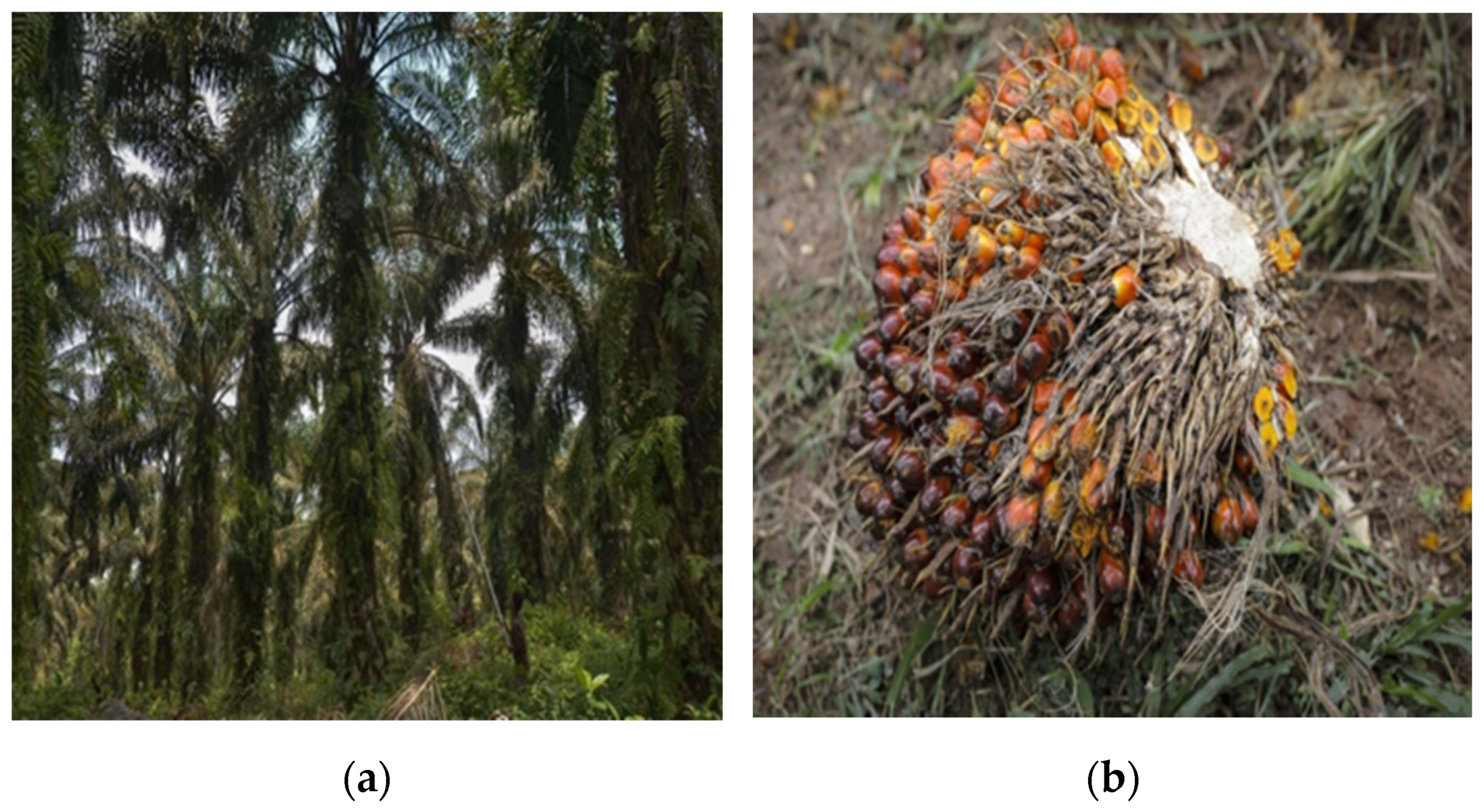
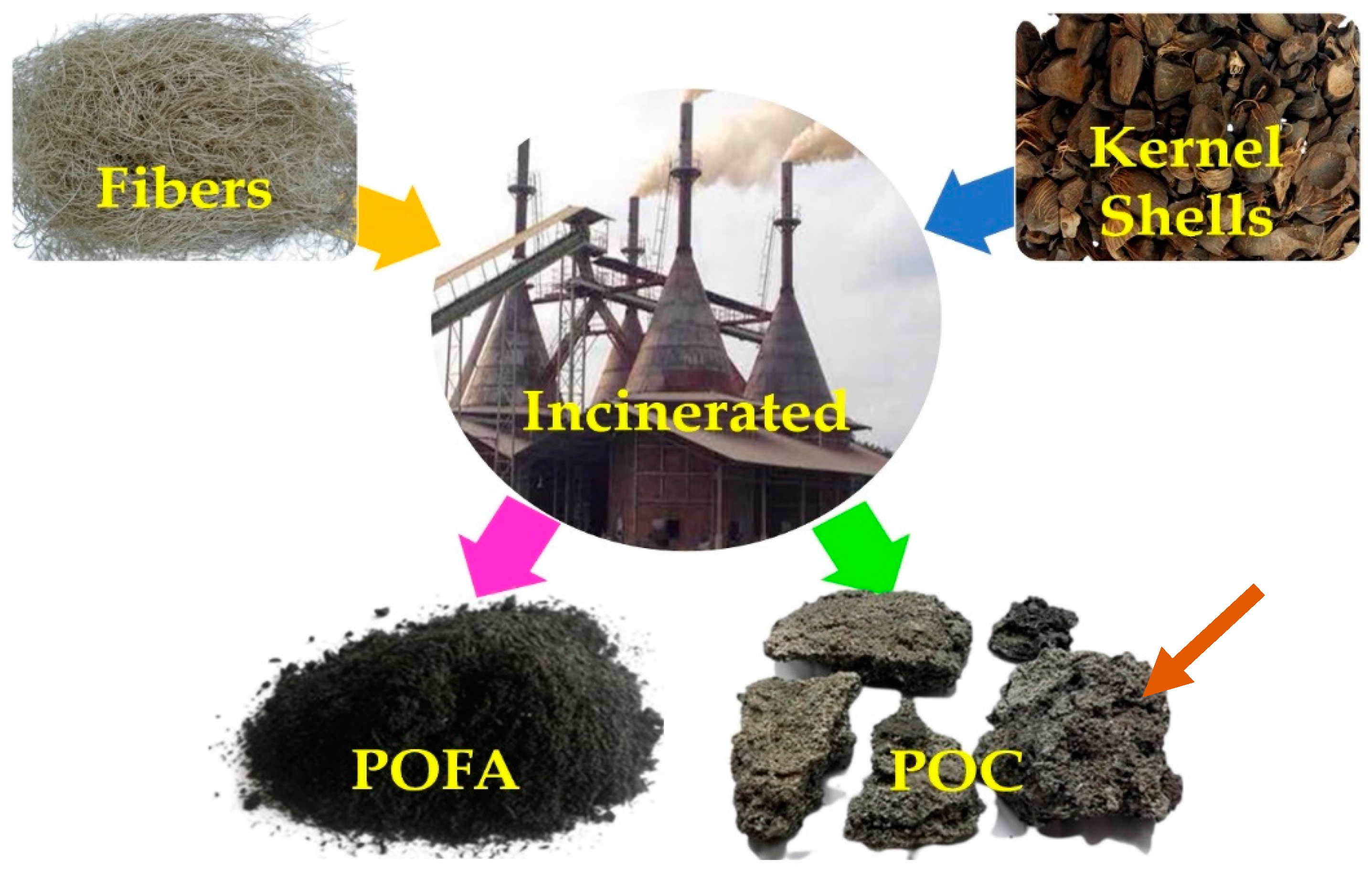

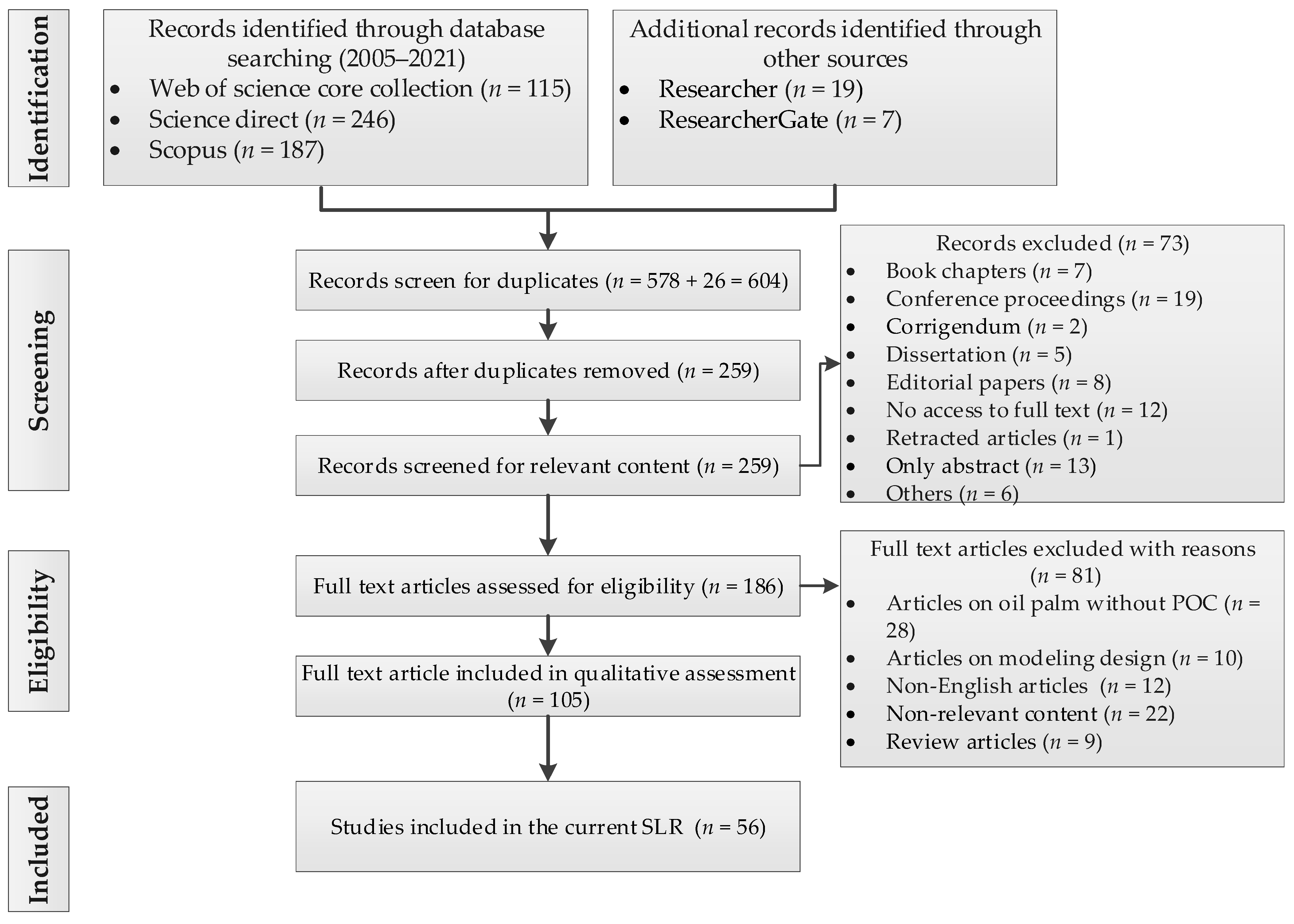

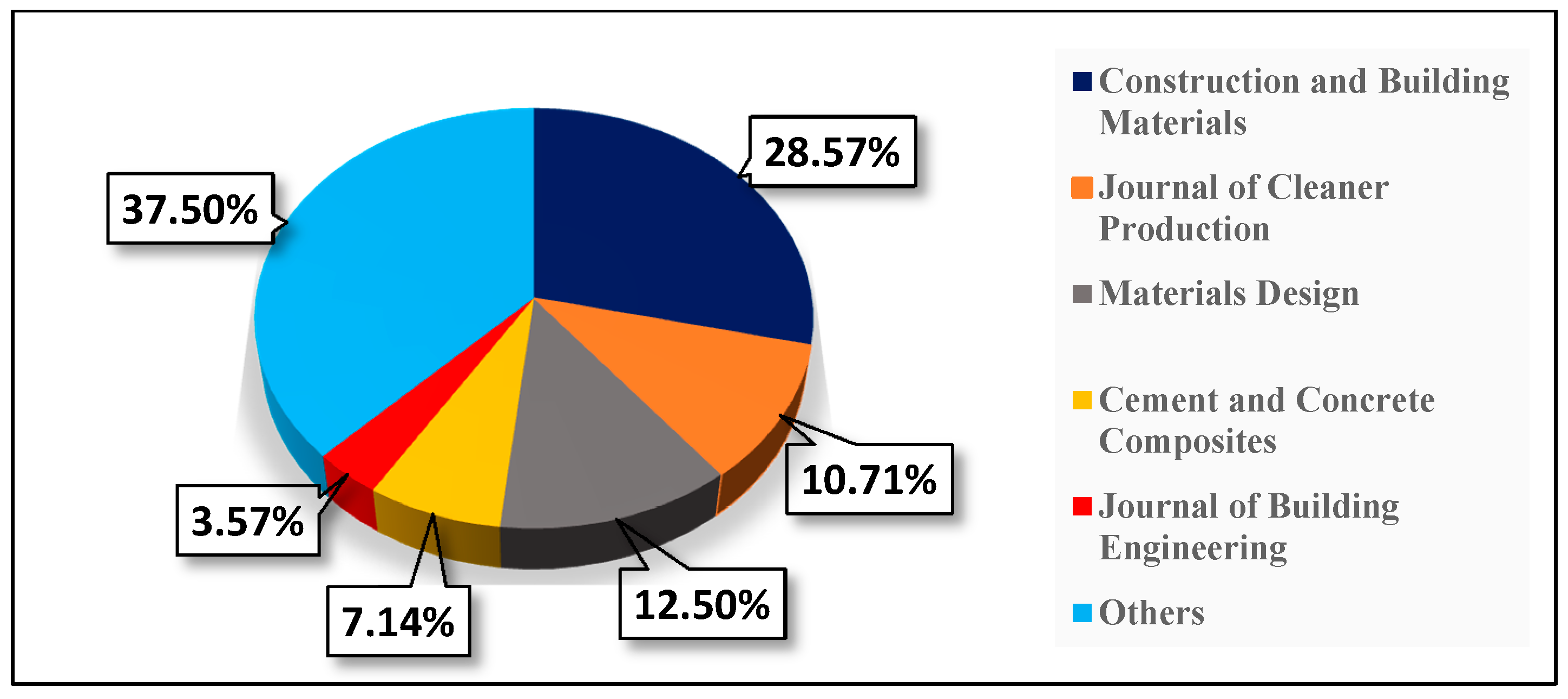
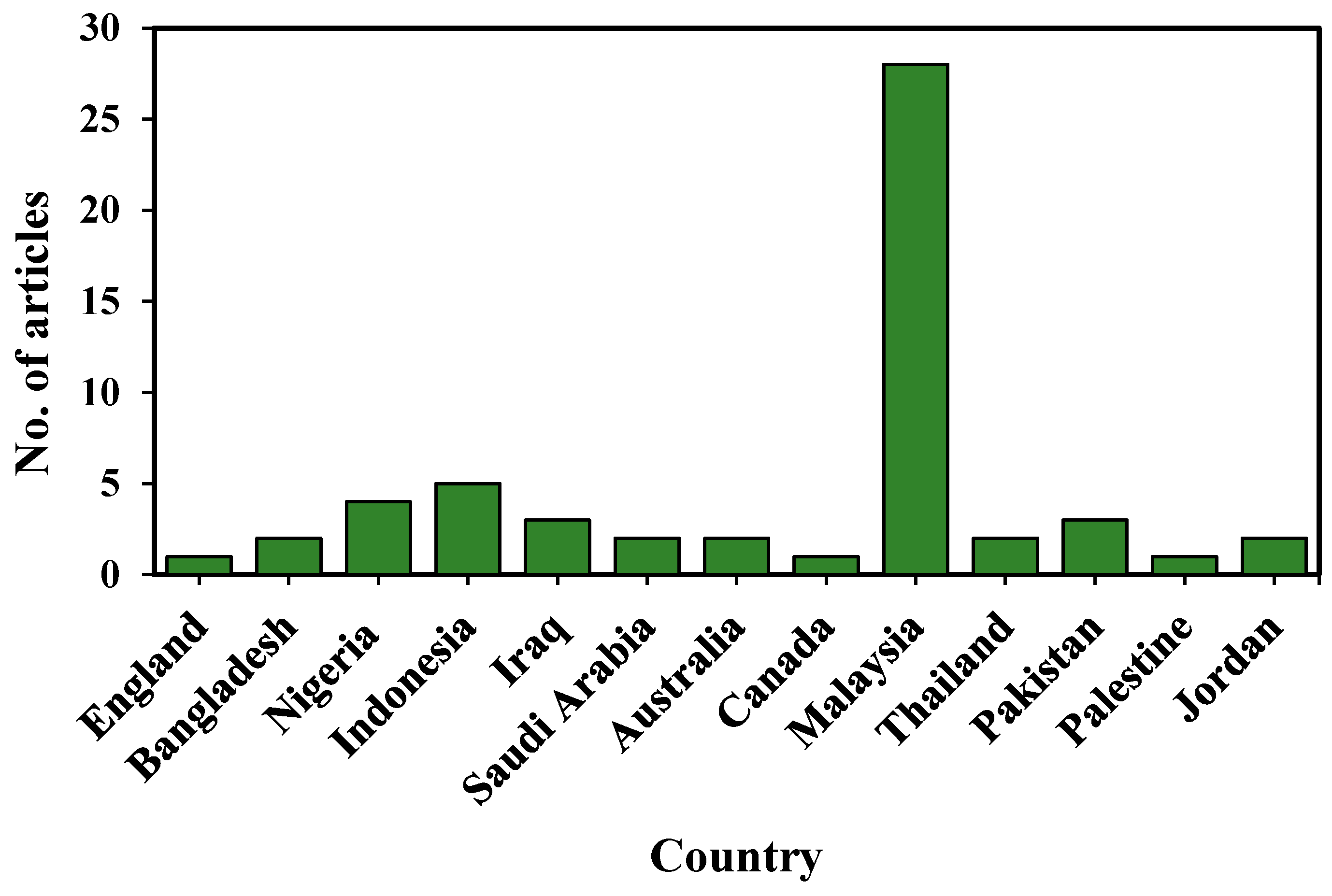

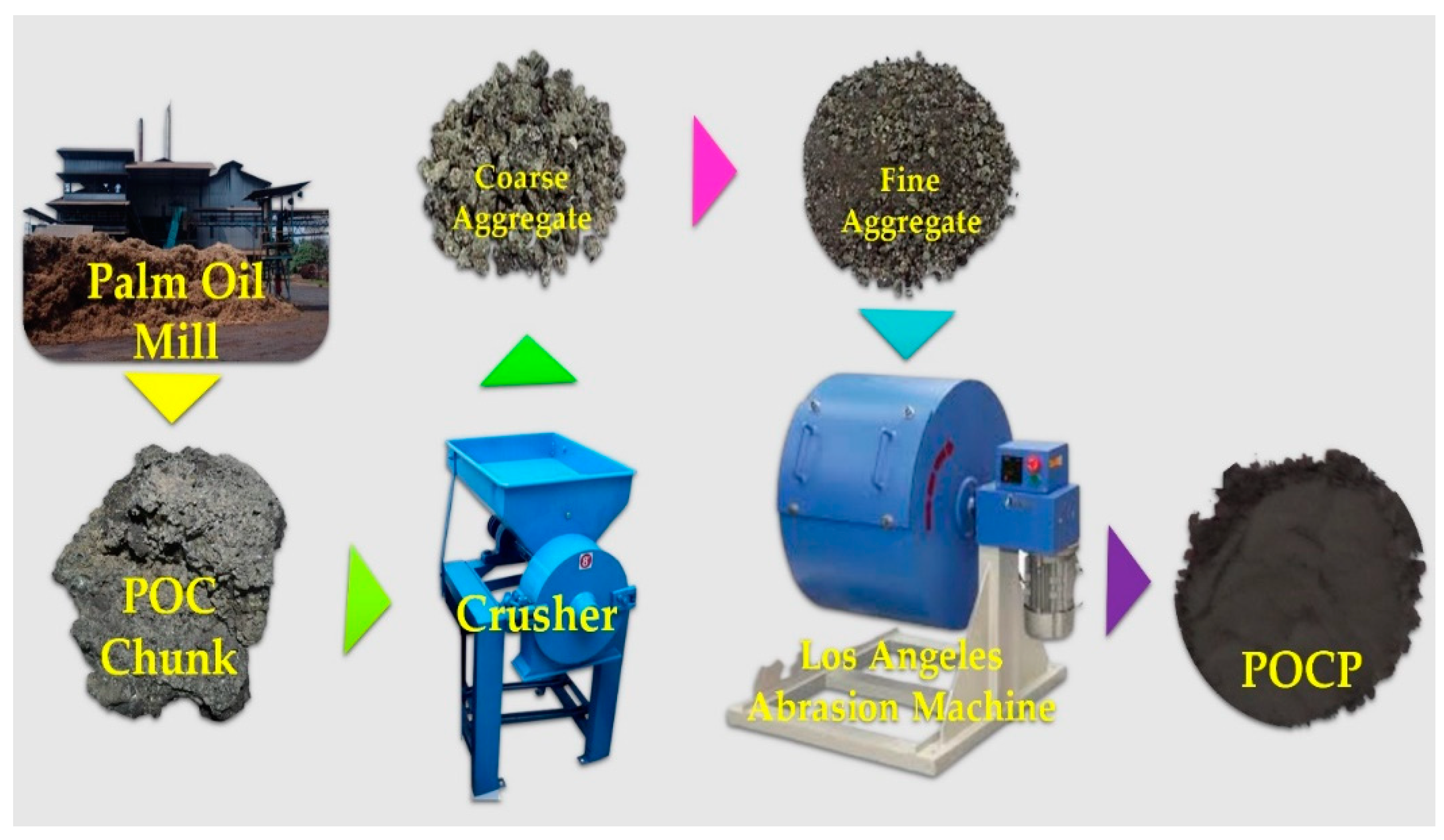
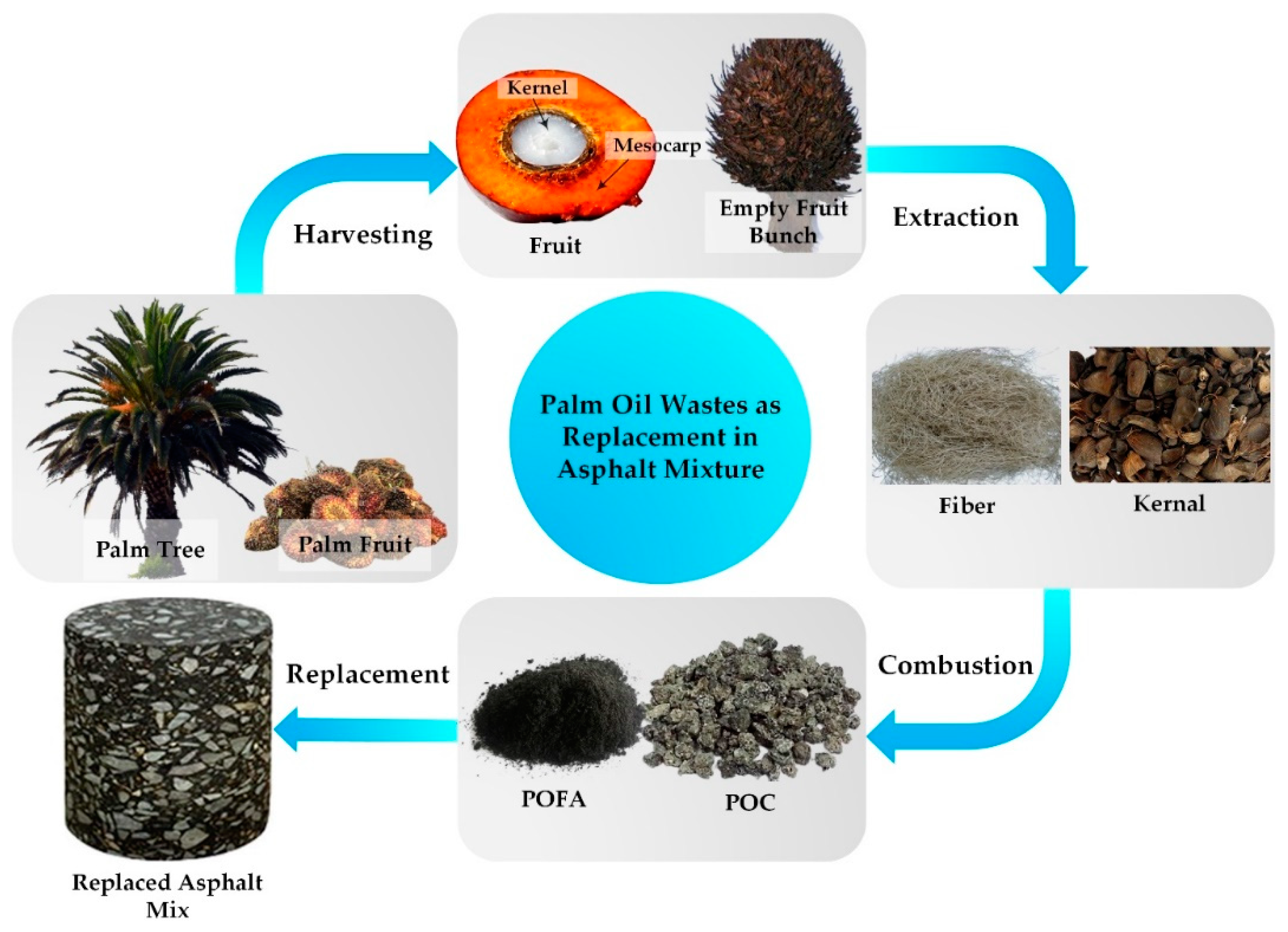
| State of POC | Chemical Composition (%) | Ref. | |||||||||||
|---|---|---|---|---|---|---|---|---|---|---|---|---|---|
| CaO | SiO2 | SO3 | Fe2O3 | Al2O3 | MgO | P2O5 | K2O | TiO2 | Mn2O3 | Na2O | Others | ||
| Coarse | 8.16 | 59.63 | 0.73 | 4.62 | 3.70 | 5.01 | 5.37 | 11.66 | 0.22 | - | 0.32 | 0.58 | [16] |
| Fine | 17.00 | 53.7 | 0.92 | 3.87 | 1.46 | 2.37 | 5.29 | 13.9 | - | - | - | - | [29] |
| Fine | 6.37 | 59.90 | 0.39 | 6.93 | 3.89 | 3.30 | 3.47 | 15.10 | 0.29 | - | - | 0.36 | [30] |
| Fine | 5.74 | 65.40 | 0.64 | 2.71 | 1.95 | 6.40 | 6.56 | 9.52 | 0.11 | 0.17 | 0.32 | - | [19] |
| Fine | 3.28 | 60.29 | 0.31 | 4.71 | 5.83 | 4.20 | 3.78 | 7.24 | 0.10 | 0.12 | 0.20 | - | [23] |
| Powder | 6.37 | 59.90 | 0.39 | 6.93 | 3.89 | 3.30 | 3.47 | 15.10 | 0.29 | - | - | 0.36 | [20] |
| Powder | 3.20 | 61.29 | 0.10 | 4.31 | 5.89 | 3.16 | 3.12 | 10.79 | 0.12 | - | - | - | [31] |
| Powder | 3.26 | 60.29 | 0.11 | 4.71 | 5.83 | 3.76 | 3.10 | 7.79 | 0.13 | - | - | - | [22] |
| Powder | 3.28 | 60.29 | 0.31 | 4.71 | 5.83 | 4.20 | - | - | - | - | - | - | [32] |
| Powder | 6.93 | 63.90 | 0.21 | 3.30 | 3.89 | 3.37 | 2.12 | 10.20 | - | - | - | - | [21] |
| Powder | 3.89 | 65.30 | 0.09 | 5.65 | 4.23 | 3.72 | 0.78 | 13.65 | 0.13 | - | - | - | [33] |
| Powder | 8.00 | 60.00 | - | 4.00 | 4.00 | 5.00 | 5.00 | 12.00 | - | - | - | 2.00 | [25] |
| Powder | 3.28 | 60.29 | 0.31 | 4.71 | 5.83 | 4.20 | 3.78 | 7.24 | 0.10 | 0.12 | 0.20 | - | [34] |
| Powder | 6.37 | 59.90 | 2.60 | 6.93 | 5.37 | 3.13 | 0.07 | 15.10 | 0.12 | 0.12 | 0.24 | - | [35] |
| Powder | 4.82 | 63.10 | 0.15 | 9.00 | 3.20 | 3.50 | 3.09 | 12.50 | 0.21 | 0.12 | 0.16 | 0.13 | [36] |
| Powder | 6.09 | 42.30 | 3.288 | 3.09 | 2.41 | 2.95 | 15.20 | 0.17 | - | - | - | [37] | |
| Powder | 7.05 | 55.39 | 0.19 | 10.81 | 2.18 | 2.00 | 3.97 | 17.7 | - | - | 0.28 | [38] | |
| Objectives | Questions | |
|---|---|---|
| 1 | To identify the most common engineering and environmental application of POC and their properties | What are the distinguishing POC properties and the most common area of application in engineering? |
| 2 | To verify the performance of POC in different forms when applied for engineering designs and manufacturing | How do POC forms and their properties affect the efficiency of engineering designs and manufacturing? |
Publisher’s Note: MDPI stays neutral with regard to jurisdictional claims in published maps and institutional affiliations. |
© 2021 by the authors. Licensee MDPI, Basel, Switzerland. This article is an open access article distributed under the terms and conditions of the Creative Commons Attribution (CC BY) license (https://creativecommons.org/licenses/by/4.0/).
Share and Cite
Jagaba, A.H.; Kutty, S.R.M.; Hayder, G.; Baloo, L.; Noor, A.; Yaro, N.S.A.; Saeed, A.A.H.; Lawal, I.M.; Birniwa, A.H.; Usman, A.K. A Systematic Literature Review on Waste-to-Resource Potential of Palm Oil Clinker for Sustainable Engineering and Environmental Applications. Materials 2021, 14, 4456. https://doi.org/10.3390/ma14164456
Jagaba AH, Kutty SRM, Hayder G, Baloo L, Noor A, Yaro NSA, Saeed AAH, Lawal IM, Birniwa AH, Usman AK. A Systematic Literature Review on Waste-to-Resource Potential of Palm Oil Clinker for Sustainable Engineering and Environmental Applications. Materials. 2021; 14(16):4456. https://doi.org/10.3390/ma14164456
Chicago/Turabian StyleJagaba, Ahmad Hussaini, Shamsul Rahman Mohamed Kutty, Gasim Hayder, Lavania Baloo, Azmatullah Noor, Nura Shehu Aliyu Yaro, Anwar Ameen Hezam Saeed, Ibrahim Mohammed Lawal, Abdullahi Haruna Birniwa, and Abdullahi Kilaco Usman. 2021. "A Systematic Literature Review on Waste-to-Resource Potential of Palm Oil Clinker for Sustainable Engineering and Environmental Applications" Materials 14, no. 16: 4456. https://doi.org/10.3390/ma14164456








